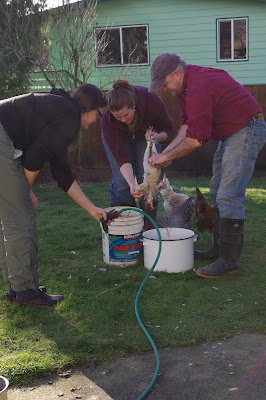Read on at your own risk:
Yesterday we culled our first chicken.
I have a lot of mixed feelings about eating animals, let alone killing them myself. I was vegetarian for over seven years in my twenties, and it was really only in the last few years that I have fully embraced and accepted being a meat eater. However, now that I do eat meat more regularly I am even more acutely aware of the adverse impact that industrial agriculture has on our planet and our society and the quality and sources of the meat available for our consumption. One of the purposes of my urban farm journey is to lead my family to a place where we are producing a majority of the meat we consume.
The first step is actually being able to slaughter my own animals and prep them for our table. We enlisted the help of a friend of ours, Greg, that spent some time in the Peace Corp in Tonga, an island in the South Pacific, where he had a lot of experience slaughtering chickens (along with many other meaningful experiences, I am sure).
As I posted about a few weeks ago, turns out we had a rooster in our last group of chicks. You may recall......I KNEW IT. In the City of Portland, it is illegal to keep a rooster, so one way or another he had to go. We decided we needed to learn how to slaughter and process our own chickens, especially since we want to get some meat chickens this summer. My friend also has a rooster she needed to cull from her flock as her and her six year old son could not even go out in their backyard anymore without being harassed and chased by him. They had considered keeping a rooster in their flock as their lot is in a bit more rural location outside of Portland, but he was becoming a nuisance. Unless you are going to breed chickens or have enough space to add to your flock using your own rooster, you need to either re-home your roosters or cull them from the flock. It is difficult to find farms around the Portland area that actually want your accidental rooster, there are just too many backyard chicken keepers trying to find non-kill options for their 90% sexed chick that happens to be a rooster.
I knew taking my rooster's life was going to be difficult for me, and it was. Taking a life should never be easy, and today was no exception. I shed tears for Coco today, surrounded and supported by the Hubs, and my friends. I will take solace in the fact that his short life was filled with days free ranging in my yard with his ladies. We did the deed as humanely and as quickly as possible using the kill cone.
 |
| Goodbye Coco, you were a beautiful bird. |
 |
| Goodbye Lucky. |
We started by setting up the kill cone, set the water to boiling in our large tub, and gathered large stainless steel bowls, knives and ice to the station we set up in our backyard.
 |
| The kill station. |
 |
| Coco was a very large bird, it did take two of us to hold him. |
Next step was dunking the carcass in very hot water to loosen the feathers.
It was surprising how easily the feathers came out. At this point we were all reminded that yes, chickens are carnivorous and cannibalistic left to their own devices. Note my older girls hovering behind us.
We removed the feet and then placed the bird in a tub of ice water to chill it quickly.
While Coco was chilling, Brit said her goodbyes to Lucky. Lucky was dispatched just as quickly and after plucking we set him to chilling while we butchered the other carcass.
We did not have a scale, but I think that Coco after gutting, weighed in at about 7 pounds.
When butchering a chicken the main idea is to keep the digestive system in tact as much as possible so you do not soil your meat. Use a very sharp knife and make shallow cuts.
First you remove the oil gland just below the tail and throw it away. We then carefully separated the esophagus and the windpipe from the neck, removed the crop and threw it away.
 |
| Intestines and gizzard. |
We saved the gizzard, liver and the heart, many people enjoy these organs, however the Hubs and I are not those people. Greg intends to take them home with him. The gizzard has to be split open and the inner lining removed. The lining of the gizzard is really tough as it has to be to hold all that grit they use to grind their food.
Here Brit is holding the gizzard and you can see the yellowish lining.
As you can see, Pepper is lurking - again.
The Hubs made our bird into a fantastic Hungarian Paprikash, which we thoroughly enjoyed.
Now that the pesky cockerel is gone, the girls can get back to their leisurely life foraging and sunbathing at the Pollo Loco convent.
Eureka says "Rooster, what rooster?"






.JPG)
You did a great job for your first time! I hope that one day we'll have space to raise our own birds and rabbits for meat. For now we have a small flock for eggs.
ReplyDeleteThanks Alexis, for the support. Definitely a milestone for me, and I am still processing the experience!
DeleteI am so proud of you! An amazing job well done. Wow.
ReplyDeleteFine job. Looks like everything went as planned and the orange cone is GENIUS! This reminds me of an episode on The Perennial Plate. Watch this episode then start at Episode 1 if you are inclined. Their journey and stories remind me of you.
ReplyDeletehttp://www.theperennialplate.com/episodes/2010/11/episode-36-giving-thanks-to-turkeys/